When you’re a small startup with only a few like-minded people on a single team, of course you can be flexible.
But if you do things right, you won’t stay small forever. With each hire, the Agile team grows, and staying Agile becomes more of a challenge. The Scaled Agile Framework — SAFe for short — can help you stay nimble and follow Agile principles, even with 1000s of employees.
In this article, we break down what SAFe is, its benefits, when it’s a good or bad idea, and how you can start to implement it.
What is the Scaled Agile Framework (SAFe)?
The Scaled Agile Framework is a patchwork framework of various techniques and concepts designed to help enterprises become more Agile — despite their size.
For example, SAFe emphasizes both Lean and Agile values in leadership, a mix of Scrum and eXtreme Programming for teams, and an organization-wide focus on customers through Design Thinking. You can make sure your team is using design thinking throughout the entire project by using design thinking tools.
It also includes a focus on DevOps development practices like Continuous Integration.
And this is all included in the most “basic” version of SAFe — the Essential level. It’s aimed at smaller organizations or departments within a larger enterprise.
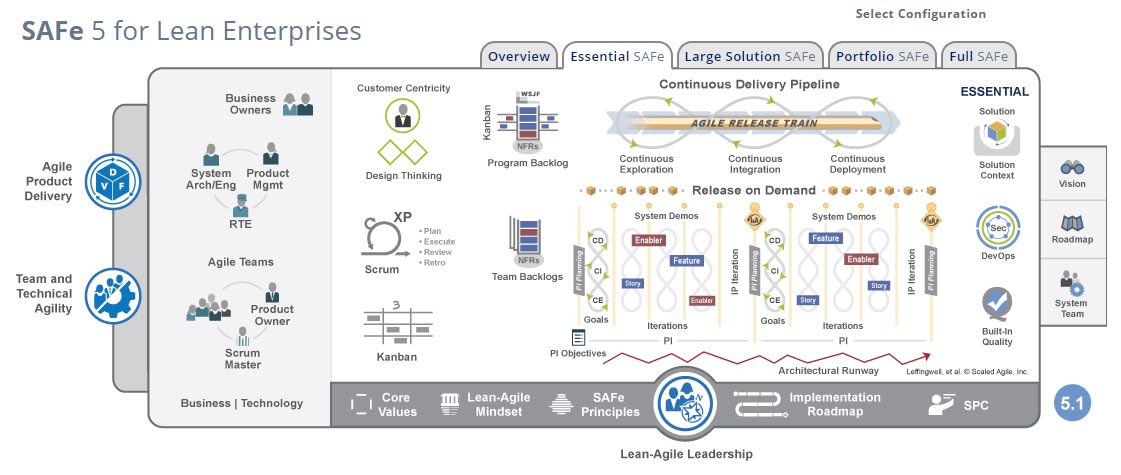
So don’t expect us to teach you the ins and outs of SAFe in a couple of paragraphs. At least we distilled it into 2,000 words rather than 10,000+.
What are the 4 levels of Scaled Agile Framework?
In SAFe 5 — the latest version — the 4 levels are Essential, Large Solution, Portfolio, and Full.
These levels indicate different versions of SAFe, designed for organizations of different sizes and with various regulatory requirements.
- Essential level: the “bare minimum” for managing a large number of projects and Agile teams, includes Kanban, Scrum, Design Thinking, and more. This level was made by merging the previous Team level and Program level into one option in SAFe 5.
- Large Solution level: all of Essential, but with another level for managing regulations, stakeholder relationships, and control high-level plans.
- Portfolio level: adds portfolio management, strategic objectives, high-level resource management, and more.
- Full SAFe: includes everything listed above.
With every level, you can feel the scale of SAFe’s ambition. It’s a framework for the big leagues.
SAFe vs. other Agile scaling frameworks
SAFe is by far the most used framework for implementing Agile at scale.
According to data from the 2020 Status Quo (Scaled) Agile report, SAFe is easily the most popular choice.
Over half of Agile enterprises that use scaling frameworks use SAFe. The only close runner-up is custom in-house frameworks.
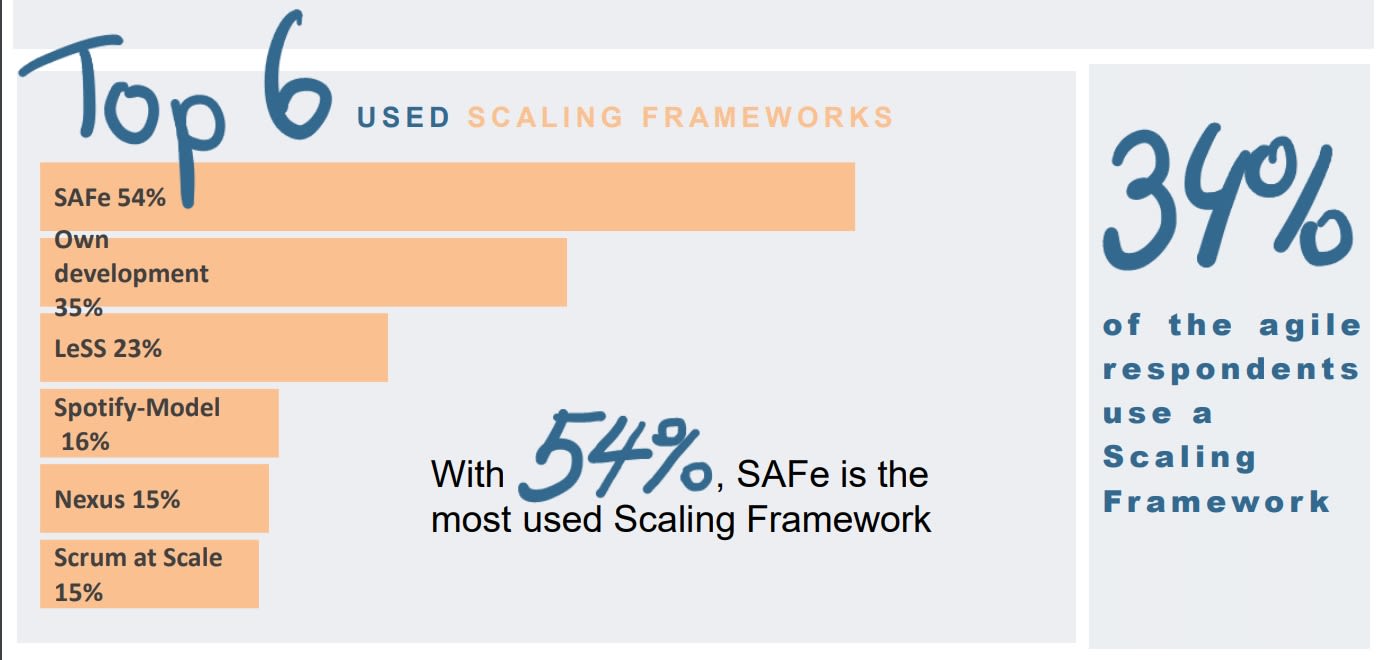
A closer look at the other frameworks shows why most companies choose SAFe or building from scratch.
The LeSS (Large Scale Scrum) framework focuses on scaling Scrum without much attention to the surrounding business processes in a large organization. It expects all teams to self-organize between themselves.
According to the co-author of the original white paper, the Spotify Model isn’t exactly a framework. It’s an aspirational model that they never implemented successfully.
We’re big fans of Spotify, but when it comes to project management, we call it like we see it.
The original Scrum creators have also released their own frameworks for scaling Agile.
Jeff Sutherland developed and released Scrum@Scale in 2014. It structures the whole organization into a Scrum of Scrums. Unsurprisingly, the SoS is a unit of multiple Scrum teams working together.
The other Scrum co-creator, Ken Schwaber, created the Nexus framework in 2015. It’s a basic approach for scaling up Scrum to integrate multiple teams working together on a single product.
While LeSS and Nexus are good options for smaller companies focused on a single product, they fail to reach the enterprise level. Even in 2021, SAFe is the obvious choice for a large organization.
What are the SAFe principles?
SAFe’s 10 Lean Agile principles focus both on processes and value, and iterations and decentralization. In other words, SAFe merges core aspects of Lean and Agile concepts into one philosophy.
- Take an economic view. Focus on value maximization and reducing running costs, as you would in Lean.
- Apply systems thinking. Don’t lose sight of the big picture when trying to optimize a single process.
- Assume variability, preserve options. Don’t settle on design options before they prove to be the best choice, empirically.
- Build incrementally with fast, integrated learning cycles.
- Set realistic milestones based on your workflow. For example, the final release of a product increment.
- Visualize and limit work-in-progress, reduce batch sizes, and manage queue lengths. Keep your focus narrow.
- Apply cadence, synchronize with cross-domain planning. Focus on the rhythm to maintain momentum.
- Unlock the intrinsic motivation of knowledge workers. Developers, programmers, and designers already want to do good work. Don’t get in their way.
- Decentralize decision-making. Managers don’t have a monopoly on good ideas, and always waiting for their input creates bottlenecks.
- Organize around value. Focus everything on the value you can deliver to customers.
What are the benefits of the Scaled Agile Framework?
Some of the main benefits of using the SAFe framework are better cooperation between teams, planning security, and customer satisfaction.
Luckily, you don’t need to take our word for it. A 2020 study by Koblenz University of Applied Sciences backs us up.
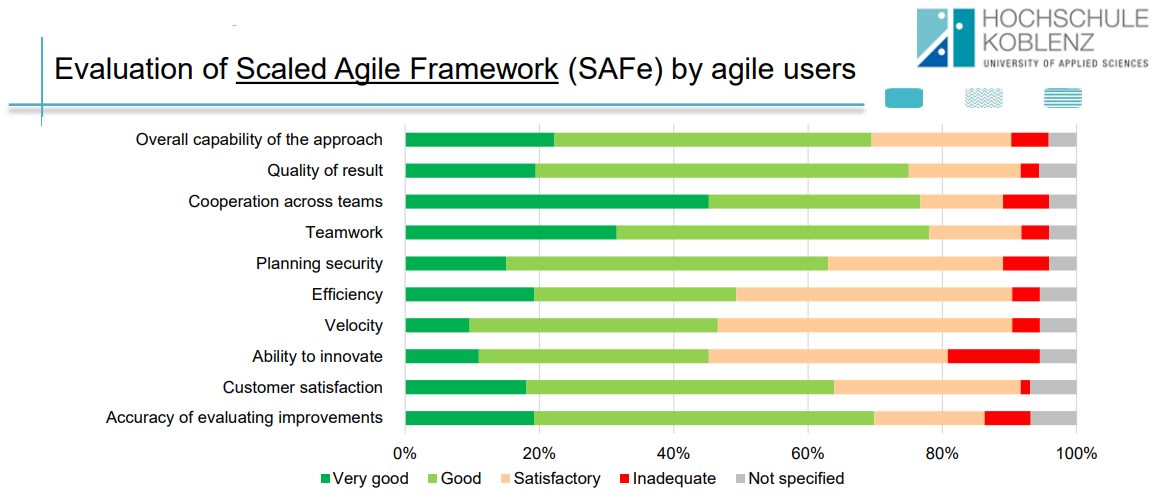
The majority of respondents felt SAFe was good or very good at facilitating:
- Teamwork
- Cross-team collaboration
- Planning security
- Customer focus
But it’s not all roses and sunshine. The complexity and different moving parts in the SAFe framework have some downsides.
Less than 50% of the respondents felt that SAFe does a good job at:
- Ensuring high velocity
- Efficiency
- Innovation
While SAFe offers reliable processes for managing your company at a high level, you give up some of the speed that other Agile frameworks deliver.
SAFe vs. Scrum vs. Waterfall
In this section, we’ll compare SAFe to Scrum and the traditional Waterfall methodology.
Let’s take a look at some of the core differences between these approaches:
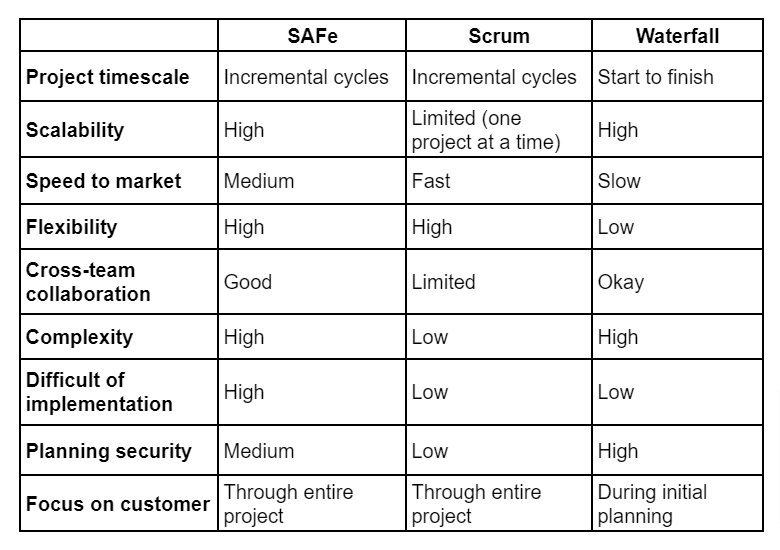
SAFe is a framework for scaling Agile, but its innate complexity slows down the velocity. It may not win on speed, but it’s an excellent option for maintaining customer-centricity and flexibility at scale.
Scrum offers the fastest speed to market and the most flexibility, but it struggles with scale and cross-team organization.SAFe is a framework for scaling Agile, but its innate complexity slows down the velocity. It may not win on speed, but it’s an excellent option for maintaining customer-centricity and flexibility at scale.
SAFe and Scrum both feature the “Scrum Master” role, but they’re not the same thing. Their responsibilities are like night and day.
A SAFe Scrum Master acts more like an organization-wide consultant. They advise on high-level issues like predictability and flow rather than leading one Scrum team. They act more like an Agile Coach.
Waterfall offers scalability and easy standardization, at the cost of flexibility, speed, and customer involvement. You can minimize the issues by adapting some Agile practices into the process.
Is SAFe the right choice for your company?
Unlike Scrum, as an organization-wide — or at least program-wide — framework by default, you can’t choose SAFe on a project-by-project basis.
Instead, you need to make the required up-front investment of learning and adopting the framework throughout your organization. It’s a framework that aims to manage all projects better, after all.
What companies use Scaled Agile?
With the focus on scale, it’s no surprise to see the large enterprise well represented. FedEx, American Express, NTT Data, and Nokia Software all use SAFe to different extents.
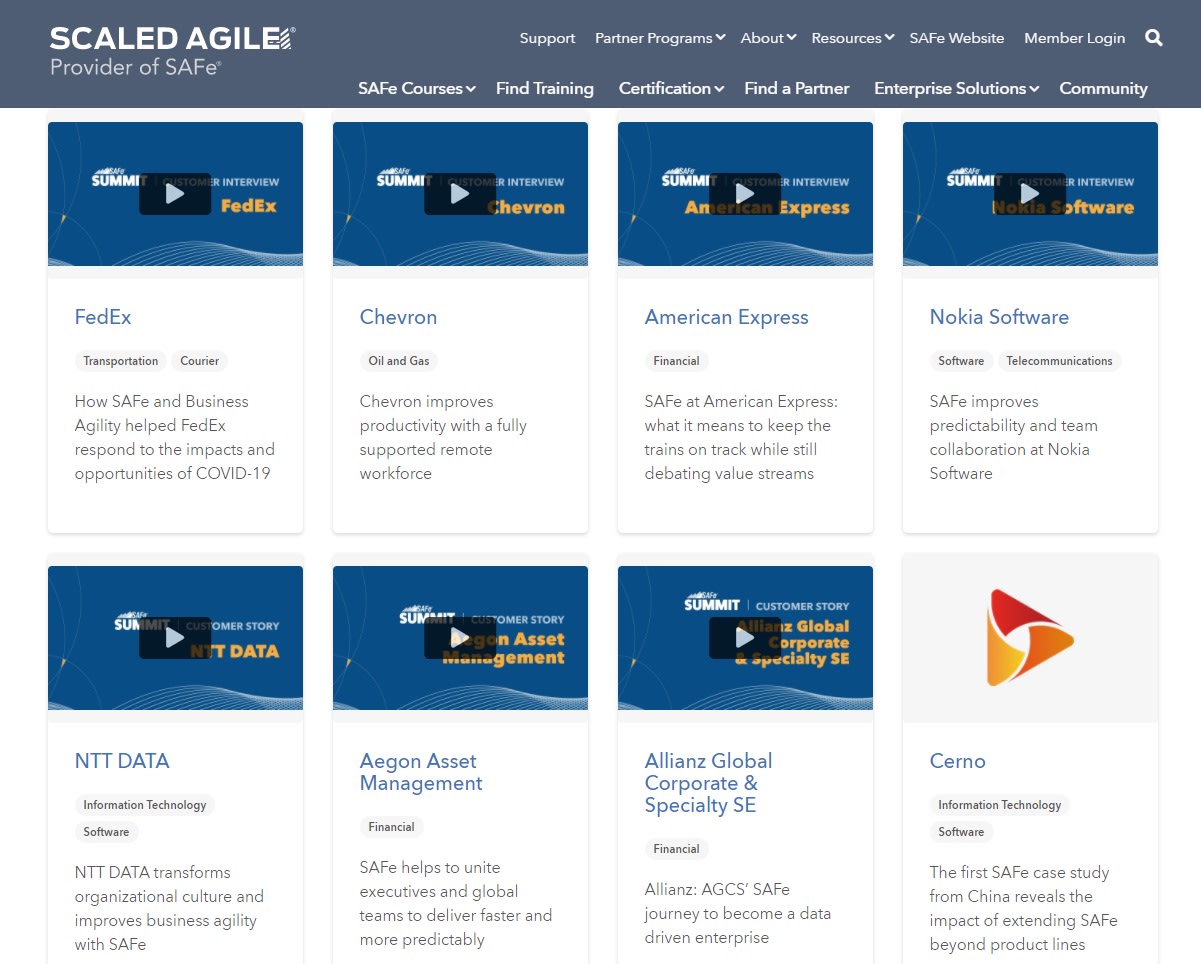
The list of users also includes companies you wouldn’t typically associate with Agile, like Chevron, a multinational oil and energy company.
Why might that be? Unlike typical Agile frameworks, SAFe also accounts for strict regulations and crushing price pressure.
We’ve already covered the benefits in detail, so let’s take a closer look at SAFe’s shortcomings.
What are the downsides of SAFe?
SAFe’s greatest strength is also its greatest weakness. The complex mix of different frameworks and techniques makes it tough to implement.
The focus on system-wide change and variability can also slow down the velocity of new projects.
Not to mention, it’s not like you’re adopting SAFe in a vacuum. Your departments, teams, and employees already have their tried and tested methods.
And in the State of Agile survey, the no. 1 challenge to adopting and scaling Agile was a resistance to change.
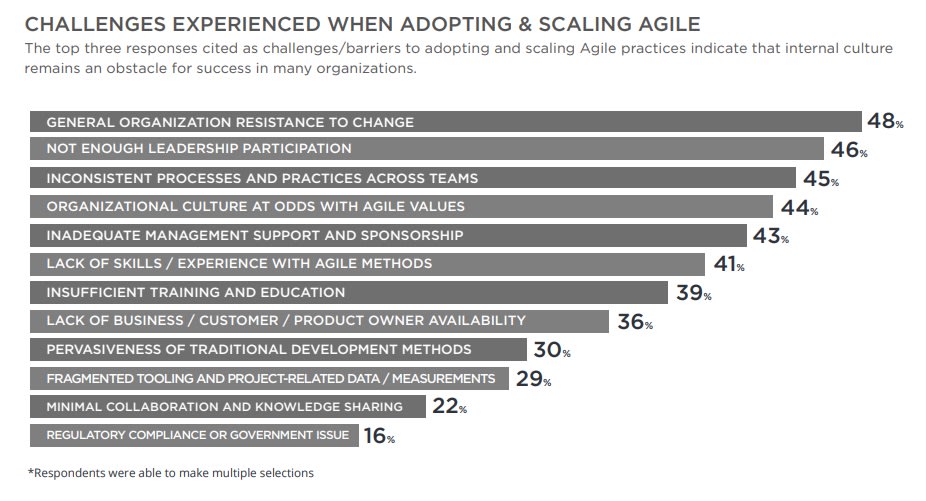
The more complex the new framework is, the more difficult the transition will be. As a whole organization, the journey to SAFe will be a challenge. The Agile principle of speed gets lost in the process.
But for some companies, the work will be worth it. An Agile release train can transform how your company works.
Companies that will benefit from SAFe
SAFe is a viable choice for many companies, and, for some, it’s a complete no-brainer.
Companies that meet these criteria will benefit from SAFe:
- Large companies that struggle to maintain the focus on the customer
- Large companies in fast-moving industries where flexibility is vital
- Medium-sized companies that manage a wide portfolio of different projects
- Companies in regulated industries with demanding external stakeholders
- Companies with tough price pressure and demanding customers that want to go Agile
Don’t brush SAFe off even if none of these describe your situation perfectly. It’s a non-exhaustive list that focuses on ideal use cases.
If you want to focus more on customers, manage stakeholders better, and remain flexible from planning to execution, SAFe could be right for your company.
How monday.com can help you better implement SAFe throughout your company
Changing project management frameworks is like shifting the foundation of your company. It’s a huge change, and you need the right tools and approach to do it successfully.
monday.com is a Work OS with the features, extensibility, and integrations you need to create a stable base for your company.
Standardize workflows with custom boards and access control
When you’re trying to make the transition, standardization is your best friend. If you can’t give your teams ready-made tools, they’ll create something unique.
For example, you can easily customize our feature backlog template to create a program backlog.
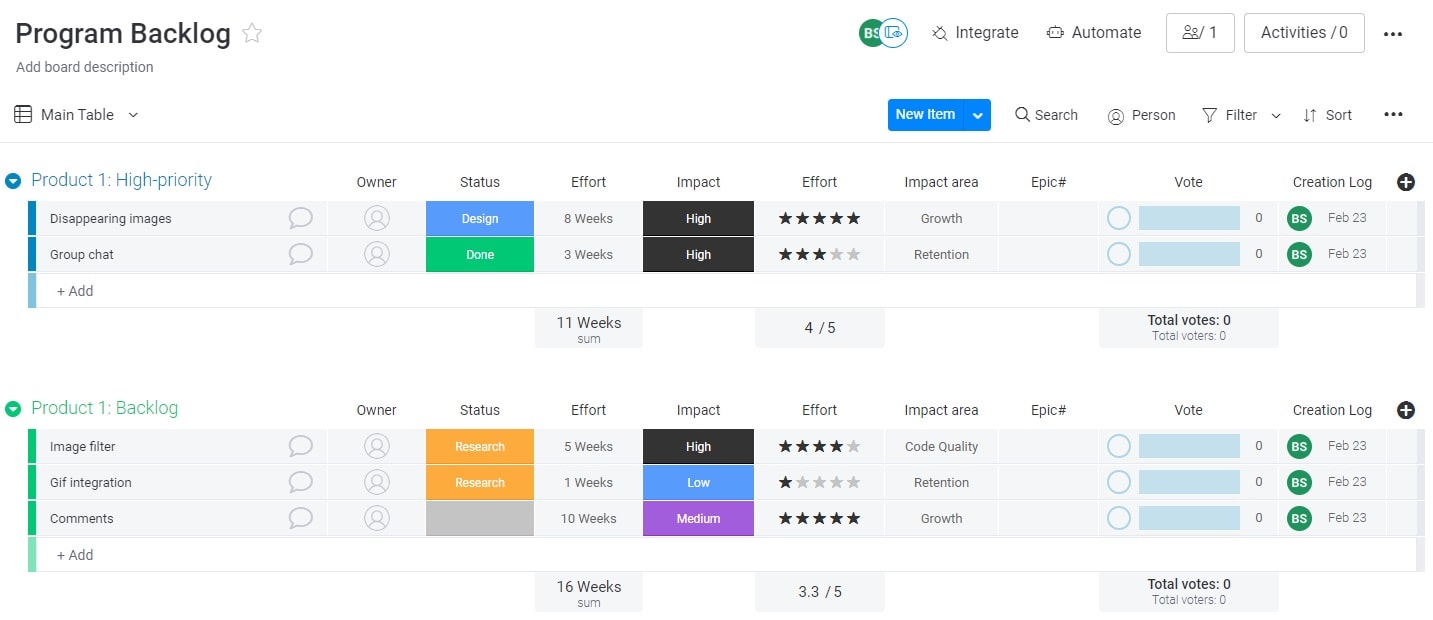
Control the user access to each board with user permissions. You can give view-only access to low-level stakeholders and team members. That way, you can avoid unwanted edits.
You can also limit the number of boards visible to different users. When nobody sees more than they need to, it’s easier to focus on work.
Use robust integrations to destroy cross-departmental data silos
In 2021, no office or department is complete without its own suite of SaaS tools. That can create problems, as manually sharing that data is time-consuming and often gets overlooked.
Enter monday.com. With over 40 native integrations, you can easily crush data silos created by different teams using different tools.
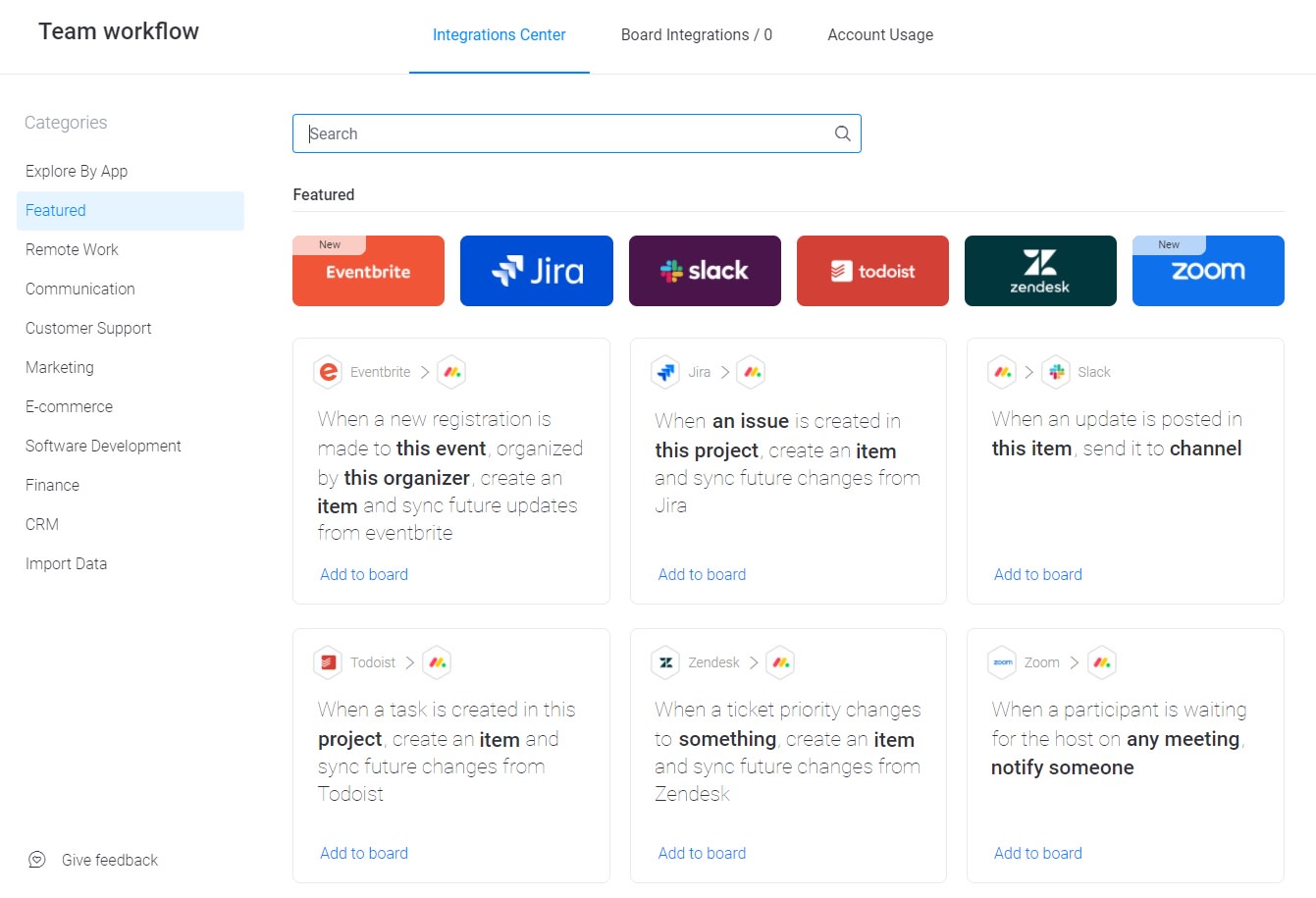
For example, you can connect all data from the development team (Jira), the support team (Zendesk), and the rest of the company.
With monday.com, you can sync items with issues from 3rd-party platforms, send automated messages, and more.
Centralizing data leads to better collaboration and more realistic high-level decision-making.
Use the monday.com Apps Framework to build the functionality you need
Whether you’re an enterprise — or a smaller company with a varied portfolio of projects — it might feel like no project management tool is up to the task.
With our low-code Apps Framework, you can build the functionality you need without big budgets or long timelines.
Our API and 50+ ready-made adaptors make it easy to set up new integrations — even with your own custom-developed tools.
Keep your company nimble with the SAFe and monday.com
Size doesn’t have to mean the end of agility, speed, connectivity, and other Agile principles.
By finding and adapting the right version of SAFe, you can use a tailored mix of frameworks, concepts, and techniques to maintain your ideal company culture.
To make integrated, company-wide change possible, you need a reliable, accessible platform that all your teams can use effectively.
The unique features, usability, and extensibility make monday.com the perfect fit for SAFe organizations.

